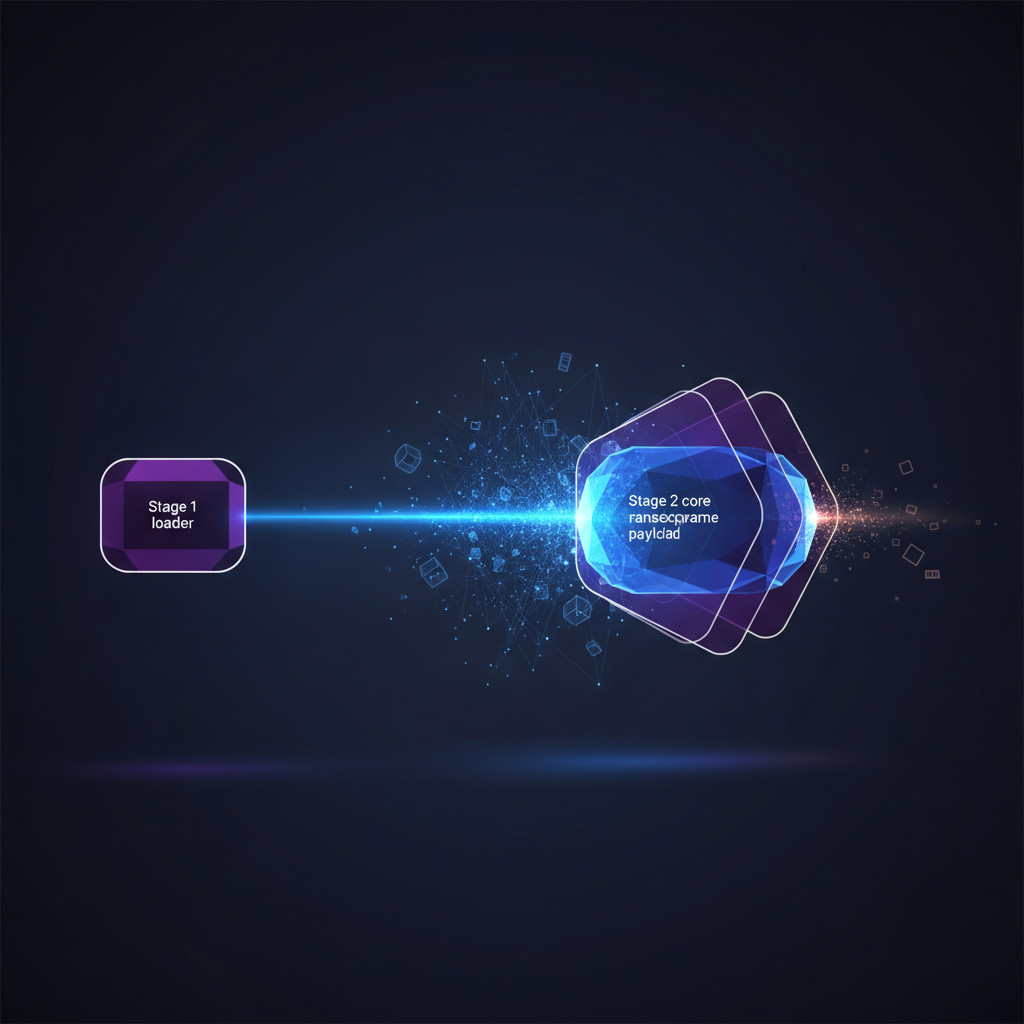LockBit 5.0: A New Era in Ransomware-as-a-Service
LockBit 5.0 arrived as a sharp evolution in ransomware-as-a-service and it demands urgent attention. Its modular, two-stage deployment architecture pairs a stealthy loader with the ChuongDoung Locker v1.01 payload. Because it uses aggressive EDR evasion, advanced anti-analysis, and repeated library unhooking, defenders face new challenges. Stage one hides execution via dynamic API hashing and clean NTDLL reloads. Stage two then injects a multi-threaded XChaCha20 encryptor into a suspended process.
In this article, we will unpack LockBit 5.0 tactics and explain their impact on incident response. You will learn detection strategies focused on behavior analytics, threat intelligence fusion, and full lifecycle playbooks. We also examine covert features like destruction-only mode and omitted ransom notes. Finally, the piece offers practical controls and response steps for blue teams. Read on to prepare your defenses and to close the gaps that LockBit 5.0 exploits.
We will reference telemetry and technique indicators throughout, and we will highlight mitigation priorities. Because attackers professionalize, access brokers and infostealer networks now feed initial compromises. This introduction primes technical readers for detailed tactics, detection, and response guidance ahead.
LockBit 5.0: Key features and impact
LockBit 5.0 raises the bar for ransomware-as-a-service operators. It builds on v4.0 yet adds stealth and modularity that defeat many classical controls. As a result, defenders must change detection and containment tactics.
Key technical features
- Two-stage deployment architecture: Stage 1 is a stealthy loader. Stage 2 is the core payload, ChuongDoung Locker v1.01, delivered only after stealth checks. This split reduces detection windows.
- Advanced EDR evasion: The loader reloads clean copies of NTDLL and Kernel32 from disk to overwrite security hooks. Therefore, common user-mode hooks become ineffective.
- Dynamic API resolution: The loader resolves APIs via custom hashing. As a result, static IOCs lose value and signature detection weakens.
- Repeated library unhooking: Stage 2 unhooks every loaded DLL repeatedly. This technique denies analysts reliable runtime hooks.
- Process hollowing and injection: The payload uses process hollowing into a suspended defrag.exe process and ZwWriteProcessMemory for stealthy execution.
- Cryptography and performance: Multi-threaded encryption uses Curve25519 keys and XChaCha20 ciphers. This accelerates encryption and complicates key recovery.
- Stealth and destruction modes: LockBit 5.0 supports a destruction-only mode that omits file extensions and ransom notes. Consequently, incidents can remain silent for longer.
- Pre-encryption disruption: The payload disables VSS, Windows Search, and Edge Update before encrypting files, which hinders restoration efforts.
- Geographic controls and affiliate dynamics: It avoids execution in Russia and select allied locations. Additionally, professional access brokers and infostealer distributors feed affiliates.
Distinctive differences from previous versions
- Because it separates loader and payload, LockBit 5.0 reduces forensic artefacts at initial compromise. This differs from v4.0 monolithic drops.
- It expands obfuscation and anti-analysis far beyond earlier builds. Therefore, sandbox and automated detonation yield fewer useful indicators.
- It introduces stealth execution that omits ransom notes. As a result, detection that relies on visible indicators will miss many attacks.
Known analyst attention and observed impacts
Researchers at Flashpoint and Cyber Press have highlighted these behaviors in telemetry. They warn that traditional signature and IOC programs will lag. Consequently, organizations must prioritize behavioral detection, threat intelligence fusion, and comprehensive incident response across the full attack lifecycle.

Comparing LockBit 5.0 with earlier releases
The table below highlights technical evolution. It shows why LockBit 5.0 demands different response tactics.
| Version | First seen | Architecture | Encryption and key handling | Evasion and anti-analysis | Propagation and initial access | Visibility and ransom notes | Typical ransom range | Impact on incident response |
|---|---|---|---|---|---|---|---|---|
| v2 | Pre-2021 | Monolithic drop, single-stage | Standard hybrid symmetric/asymmetric | Basic obfuscation; limited sandbox evasion | Credential theft, phishing, basic lateral tools | Ransom notes present; visible file extensions | Low to moderate | Focused on containment, restore from backups |
| v3 | 2021-2022 | Modular but mostly single payload | Hybrid encryption; faster crypto routines | Improved packing, some anti-analysis | Greater use of RDP compromise and stolen credentials | Ransom notes and data leak extortion common | Moderate to high | Longer dwell times; expanded extortion |
| v4 | 2023-2024 | More modular; improved loader/payload separation | Faster encryption; stronger obfuscation | Aggressive EDR evasion begins; API obfuscation | Wide use of access brokers and infostealers | Ransom notes standardized; double extortion growth | High | More complex forensics; need for threat intel fusion |
| LockBit 5.0 | Late September 2025 | Two-stage architecture: stealthy Stage 1 loader and Stage 2 ChuongDoung Locker v1.01 | Multi-threaded encryption with Curve25519 keys and XChaCha20 ciphers | Repeated DLL unhooking, dynamic API hashing, NTDLL and Kernel32 reloads; process hollowing and ZwWriteProcessMemory | Access broker and infostealer supplied initial access; geographic execution controls | Stealth modes include destruction-only; omitted file extensions and ransom notes | Very high | Requires behavioral detection, full lifecycle IR, and faster threat intel sharing |
Researchers at Flashpoint and Cyber Press have observed these changes and warned about detection gaps.
LockBit 5.0 Threat Model and Impacts
LockBit 5.0 changes the threat model for enterprises and for defenders. Because it combines stealth loaders with the ChuongDoung Locker v1.01 payload, ransomware incidents now often begin without visible signs. As a result, organizations face longer dwell times and harder forensic collection.
Common attack vectors and typical targets
- Initial access often comes from access brokers and infostealer-distributed credentials, not only phishing. Therefore, identity and credential hygiene are critical.
- Lateral movement uses living-off-the-land tools and process injection, which helps attackers evade traditional detection.
- Target industries include healthcare, manufacturing, finance, and managed service providers, because these sectors hold sensitive data and rely on high uptime. Flashpoint telemetry shows increased targeting of critical sectors, which raises stakes for incident responders source.
Business and operational impacts
LockBit 5.0 increases the chance of a severe data breach and extended outage. Stealth modes and destruction-only options mean ransomware may encrypt data without ransom notes. Consequently, organizations may not detect an incident until recovery proves difficult. The payload also disables VSS and search services, so restores fail more often and downtime costs rise.
Defense methods and hardening best practices
- Prioritize behavioral detection and EDR tuned for anomalies such as process hollowing and ZwWriteProcessMemory usage.
- Implement strong identity controls including MFA, privileged access separation, and rapid credential revocation.
- Segment networks and limit lateral protocol exposure to reduce blast radius.
- Maintain immutable, offline backups and test restores regularly to survive destruction-only scenarios.
- Fuse threat intelligence and telemetry from vendors like Microsoft for endpoint indicators and hunting guidance source.
- Follow practical frameworks such as NIST for recovery and response planning source.
Incident response and readiness
Train IR teams to hunt for subtle signs such as suspicious NTDLL reloads, anomalous defrag.exe launches, and sudden VSS disablement. Because LockBit 5.0 evades signatures, responders must emphasize live memory capture, network flow analysis, and rapid containment. Finally, share indicators with trusted intelligence partners and law enforcement to reduce affiliate reuse and future exposure.
CONCLUSION
LockBit 5.0 represents a meaningful escalation in ransomware-as-a-service tactics. It pairs a stealthy Stage 1 loader with the ChuongDoung Locker v1.01 payload, and therefore it extends dwell time and reduces visible indicators for defenders. As a result, organizations face higher risks of data breach, extended downtime, and failed restores because VSS and other services are disabled.
To manage these risks, focus on behavioral detection, rapid credential controls, and segmented network architecture. In addition, maintain immutable offline backups and rehearse recovery regularly. Threat intelligence fusion and timely telemetry sharing also matter, because signature-based controls will lag against dynamic API hashing and repeated DLL unhooking.
For ecommerce operators, consider third-party tools that harden customer data flows and automate anomaly detection. Velocity Plugins offers AI-driven plugins for WooCommerce that help improve customer engagement and add security-conscious automation. Learn more at Velocity Plugins and evaluate how their features fit into your ecommerce security stack.
Finally, invest in incident response playbooks and cross-team exercises. Only a layered, proactive defense will reduce LockBit 5.0 impact and lower breach risk.
Frequently Asked Questions (FAQs)
What is LockBit 5.0 and why does it matter?
LockBit 5.0 is the latest ransomware-as-a-service release from the LockBit family. It uses a two-stage architecture with a stealthy Stage 1 loader and the ChuongDoung Locker v1.01 Stage 2 payload. Because it emphasizes EDR evasion and advanced anti-analysis, LockBit 5.0 increases the risk of longer dwell times and hidden data breach activity.
How does LockBit 5.0 differ from earlier LockBit versions?
LockBit 5.0 separates loader and payload more cleanly than v4.0. It adds repeated DLL unhooking, dynamic API hashing, and NTDLL reloads. In addition, it uses Curve25519 keys and XChaCha20 ciphers for multi-threaded encryption. Therefore, it is harder to detect and to recover from than prior releases.
How do attackers typically gain access for LockBit 5.0 attacks?
Affiliates often use access brokers and infostealer-distributed credentials. They also exploit exposed remote protocols and stolen MFA session tokens. As a result, identity compromise and credential hygiene are central to prevention.
What detection and defense steps reduce risk?
Prioritize behavioral detection and EDR tuned for process hollowing and ZwWriteProcessMemory. Segment networks and apply least privilege for accounts. Maintain immutable offline backups and test restores. Finally, enforce strong identity controls including MFA and rapid credential revocation.
Should organizations pay a ransom after a LockBit 5.0 incident?
Paying cannot guarantee safe recovery and it may fund future attacks. Instead, coordinate with law enforcement and trusted incident responders. Also, weigh legal and breach notification obligations when considering payment.



